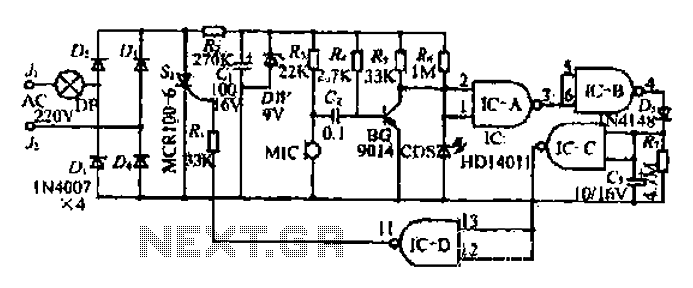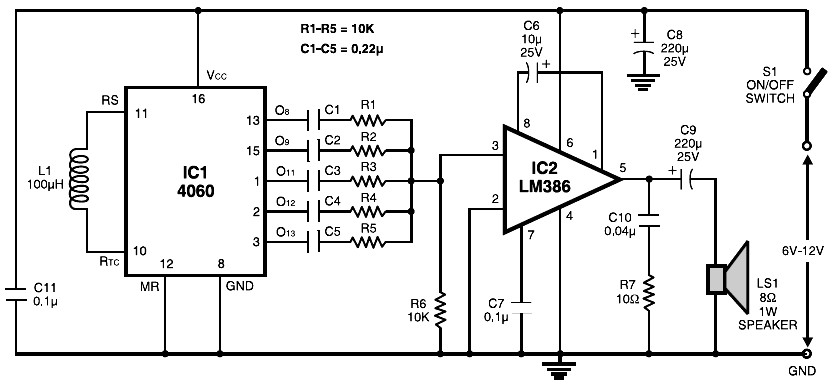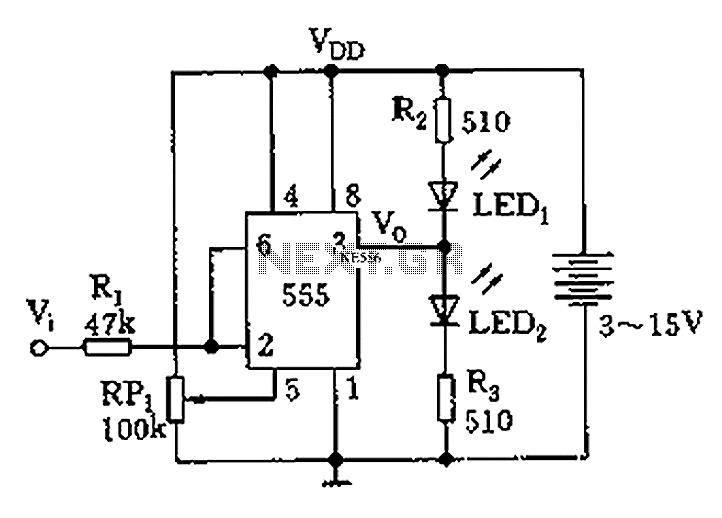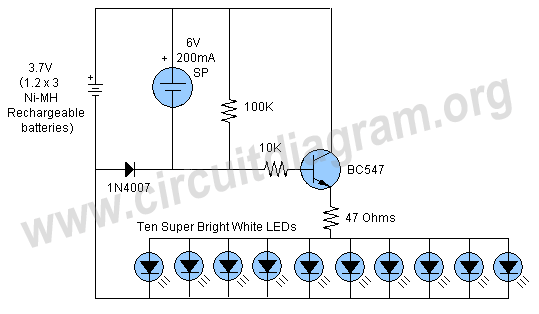
motor switch led circuit
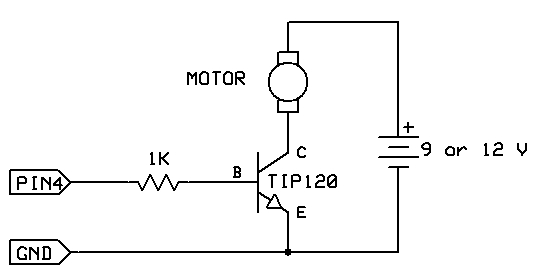
The strategy involves assembling the circuit in stages, testing each component as it is integrated. Once all connections are established and can be controlled or read correctly by the computer, the main program can be developed with assurance that all elements are functioning properly. Follow the instructions outlined in the Arduino Guide (PDF file) under the "Flashing an LED" section. Use this program to verify that the LED operates under computer control. Additionally, refer to the Arduino Guide under "Reading a Switch" to ensure that the Arduino accurately reads the switch. The stream of 1s displayed in the monitor window should switch to 0s when the switch is closed. If this does not occur, measure the voltage at Pin 3 using a digital multimeter (DMM). The voltage should read 5 V when the switch is open and 0 V when it is closed. If the readings are incorrect, disconnect the switch from the circuit and check for continuity with the beeper function of the DMM. The DMM should emit a beep when the switch is closed (indicating a short circuit) and remain silent when open (indicating an open circuit). It is possible for switch contacts to become dirty, so if a short circuit is not detected, try manipulating the switch button while it is closed. The code presumes the switch is connected to Pin 3 on the Arduino, but any pin can be utilized. It is important not to connect the motor directly to an Arduino pin or to use the 5 V power from the Arduino board to power the motor. Instead, control the motor using a TIP120 transistor and a separate 9V or 12V battery. The motor can be either a gear motor or a small motor. For the small motor, a 2N3904 transistor can be used as the switch. "Px" can represent any I/O pin on the Arduino; for this exercise, P4 should be used. Connect the negative terminal of the battery to the emitter of the transistor (E pin), and also connect the emitter of the transistor to GND on the Arduino board. It is crucial to verify these connections carefully to prevent the positive terminal of the battery from directly connecting to an Arduino pin. To check functionality, use a jumper wire to short the collector to the emitter pins of the transistor; the motor should activate. If it does not, inspect the wiring.
The circuit design described involves a methodical approach to building and testing an Arduino-based control system that integrates an LED and a switch with motor control capabilities. The process begins with the flashing of an LED, which serves as a basic confirmation of the Arduino's functionality. By following the outlined steps in the Arduino Guide, the LED's operation under computer control can be validated, ensuring that the microcontroller is correctly programmed and operational.
Next, the switch reading functionality is tested. The switch should be connected to a designated I/O pin, and the expected behavior is that the output changes from high (1) to low (0) when the switch is activated. Voltage measurements at the designated pin provide a quick diagnostic tool to confirm proper electrical behavior. The use of a DMM to check for continuity and voltage levels is critical in troubleshooting potential issues in the circuit, particularly with respect to the switch's operational integrity.
The motor control section of the circuit employs a TIP120 transistor, which acts as a switch to manage the higher current requirements of the motor without overloading the Arduino. This design choice is essential to prevent damage to the microcontroller. A separate power source, such as a 9V or 12V battery, is utilized to power the motor, ensuring that the Arduino remains within safe operating voltage levels. The transistor's emitter is connected to ground, and the collector is linked to the motor, allowing for effective control over the motor's operation through the Arduino.
For smaller motors, the 2N3904 transistor is suggested, which is suited for lower current applications. It is important to ensure that the connections are made correctly, particularly the polarity of the battery, to avoid damaging the Arduino. The jumper wire test provides a straightforward method to verify the motor's functionality, confirming that the circuit is correctly assembled and that the transistor is functioning as intended. Overall, this systematic approach to circuit assembly and testing facilitates the development of a reliable and functional electronic control system.The strategy is to get the circuit going in stages, testing each part as you go. Once everything is wired correctly and can be either controlled or read by the computer correctly, then you can write the main program with confidence that all the pieces are working. Follow the directions shown in the Arduino Guide ( PDF file ) under the "Flashing an LED" section. Use this program to confirm that the LED works under computer control Follow the directions shown in the Arduino Guide under "Reading a Switch". Use the program shown in the Guide to confirm that the Arduino is reading the switch properly. The stream of 1`s going across the monitor window should change to 0`s when you close the switch. If it doesn`t, read the voltage at Pin 3 with your DMM. It should be 5 V with the switch open and 0 V with the switch closed. If it isn`t, remove the switch from the circuit and check for continuity with the beeper function of your DMM.
The DMM should beep when the switch is closed (short circuit) and stay silent when open (open circuit). Sometimes switch contacts get dirty so if you aren`t getting a short circuit, try wiggling the switch button while it is closed.
The code assumes the switch is connected to Pin 3 on the Arduino, but any pin can be used. Do not connect your motor directly to an Arduino pin and do not use the 5 V power from the Arduino board to power your motor. Instead, control the motor using your TIP120 transistor and a separate 9V or 12V battery. The motor can be either the gear motor or the small motor. For the small motor, you can use the 2N3904 transistor as the switch. "Px" is any I/O pin on your Arduino. For this exercise, use P4. Connect the minus of the battery to the emmiter of the transistor (E pin) and then also connect the emmiter of the transistor to GND on the Arduino board.
Check these connections carefully because you never want the plus of the battery to directly connect to an Arduino pin. To check if things are working, take a jumper wire and short the collector to the emmiter pins of the transistor.
The motor should turn on. If not, check the wiring. 🔗 External reference
The circuit design described involves a methodical approach to building and testing an Arduino-based control system that integrates an LED and a switch with motor control capabilities. The process begins with the flashing of an LED, which serves as a basic confirmation of the Arduino's functionality. By following the outlined steps in the Arduino Guide, the LED's operation under computer control can be validated, ensuring that the microcontroller is correctly programmed and operational.
Next, the switch reading functionality is tested. The switch should be connected to a designated I/O pin, and the expected behavior is that the output changes from high (1) to low (0) when the switch is activated. Voltage measurements at the designated pin provide a quick diagnostic tool to confirm proper electrical behavior. The use of a DMM to check for continuity and voltage levels is critical in troubleshooting potential issues in the circuit, particularly with respect to the switch's operational integrity.
The motor control section of the circuit employs a TIP120 transistor, which acts as a switch to manage the higher current requirements of the motor without overloading the Arduino. This design choice is essential to prevent damage to the microcontroller. A separate power source, such as a 9V or 12V battery, is utilized to power the motor, ensuring that the Arduino remains within safe operating voltage levels. The transistor's emitter is connected to ground, and the collector is linked to the motor, allowing for effective control over the motor's operation through the Arduino.
For smaller motors, the 2N3904 transistor is suggested, which is suited for lower current applications. It is important to ensure that the connections are made correctly, particularly the polarity of the battery, to avoid damaging the Arduino. The jumper wire test provides a straightforward method to verify the motor's functionality, confirming that the circuit is correctly assembled and that the transistor is functioning as intended. Overall, this systematic approach to circuit assembly and testing facilitates the development of a reliable and functional electronic control system.The strategy is to get the circuit going in stages, testing each part as you go. Once everything is wired correctly and can be either controlled or read by the computer correctly, then you can write the main program with confidence that all the pieces are working. Follow the directions shown in the Arduino Guide ( PDF file ) under the "Flashing an LED" section. Use this program to confirm that the LED works under computer control Follow the directions shown in the Arduino Guide under "Reading a Switch". Use the program shown in the Guide to confirm that the Arduino is reading the switch properly. The stream of 1`s going across the monitor window should change to 0`s when you close the switch. If it doesn`t, read the voltage at Pin 3 with your DMM. It should be 5 V with the switch open and 0 V with the switch closed. If it isn`t, remove the switch from the circuit and check for continuity with the beeper function of your DMM.
The DMM should beep when the switch is closed (short circuit) and stay silent when open (open circuit). Sometimes switch contacts get dirty so if you aren`t getting a short circuit, try wiggling the switch button while it is closed.
The code assumes the switch is connected to Pin 3 on the Arduino, but any pin can be used. Do not connect your motor directly to an Arduino pin and do not use the 5 V power from the Arduino board to power your motor. Instead, control the motor using your TIP120 transistor and a separate 9V or 12V battery. The motor can be either the gear motor or the small motor. For the small motor, you can use the 2N3904 transistor as the switch. "Px" is any I/O pin on your Arduino. For this exercise, use P4. Connect the minus of the battery to the emmiter of the transistor (E pin) and then also connect the emmiter of the transistor to GND on the Arduino board.
Check these connections carefully because you never want the plus of the battery to directly connect to an Arduino pin. To check if things are working, take a jumper wire and short the collector to the emmiter pins of the transistor.
The motor should turn on. If not, check the wiring. 🔗 External reference
Warning: include(partials/cookie-banner.php): Failed to open stream: Permission denied in /var/www/html/nextgr/view-circuit.php on line 713
Warning: include(): Failed opening 'partials/cookie-banner.php' for inclusion (include_path='.:/usr/share/php') in /var/www/html/nextgr/view-circuit.php on line 713
